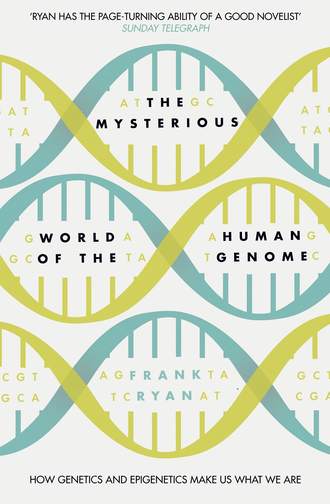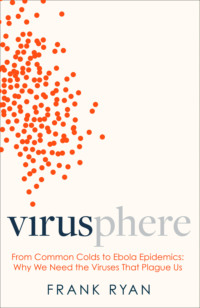
Полная версия
The Mysterious World of the Human Genome
Bacteriologists also came to recognise that the same bacterium could exist in different subtypes, which could often be distinguished from one another using antibodies. These subtypes were called ‘serotypes’. In 1921 a British bacteriologist, J. A. Arkwright, noticed that the colonies of a virulent type of dysentery bug, called Shigella, growing on the jelly-coated surfaces of culture plates, were dome-shaped with a smooth surface, whereas colonies of an attenuated, non-virulent, type of dysentery bug were irregular, rough-looking and much flatter. He introduced the terms ‘Smooth’ and ‘Rough’ (abbreviated to S and R) to describe these colonial characteristics. Arkwright recognised that the ‘R’ forms cropped up in cultures grown under artificial conditions, but not in circumstances where bacteria were taken from infected human tissues. He concluded that what he was observing was a form of Darwinian evolution at work.
In his words: ‘The human body infected with dysentery may be considered a selective environment which keeps such pathogenic bacteria in the forms in which they are usually encountered.’
Soon researchers in different countries confirmed that loss of virulence in a number of pathogenic bacteria was accompanied by the same change in colony appearance from Smooth to Rough. In 1923, Frederick Griffith, an epidemiologist working for the Ministry of Health in London, reported that pneumococci – the bugs that caused epidemic pneumonia and meningitis which were of particular interest to Oswald Avery at the Rockefeller Laboratory – formed similar patterns of S and R forms on culture plates. Griffith was known to be a diligent scientist and Avery was naturally intrigued.
Griffith’s experiments also produced an additional finding, one that really shook and puzzled Avery.
When Griffith injected non-virulent R-type pneumococci from the strain known as type I into experimental mice, he included an additional ingredient in the injections, a so-called ‘adjuvant’, which usually pepped up the immune response to the R pneumococci. A common adjuvant for these purposes was mucus taken from the lining of the experimental animal stomach. But for some obscure reason Griffith switched adjuvant to a suspension of S pneumococci, derived from type II, that had been deliberately killed off by heat. The experimental mice died from overwhelming infection. In the blood of these dead mice Griffith expected to find large numbers of multiplying R-type I bacteria – the type that he had injected at the start of the experiment. Why then had he actually found S-type II? How on earth could adding dead bacteria to his inoculum have changed the actual serotype of the bacterium from non-virulent R-type I to highly virulent S-type II?
Researchers, including Avery himself, had previously shown that S and R types were determined by differences in the polysaccharide capsules coating the cell bodies of the bugs. Griffith’s findings suggested that the test bacteria, initially R-type pneumococci, had changed their polysaccharide coats inside the infected bodies of the mice to that of the virulent strain. But they could not have achieved this by just flinging off the old coat and putting on the new one. The coat was determined by the bacteria’s heredity – it was an inherited characteristic. Further cultures of the recovered bacteria confirmed that the S type bred true. There appeared to be only one possible explanation: adding the dead S bacteria to the living R bacteria had induced a mutation in the heredity of the living R-type bacteria, so they literally transformed into S-type II.
In the words of Dubos: ‘[At the time] Griffith took it for granted that the changes remained within the limits of the species. He probably had not envisaged that one pneumococcus type could be transformed into another, as this was then regarded as the equivalent of transforming one species into another – a phenomenon never previously observed.’
*
It is little wonder that Avery was astonished by Griffith’s findings. Like Robert Koch before him, Avery subscribed to the view that bacterial strains were immutable in terms of their heredity. The very concept of a mutation – that heredity was capable of an experimentally induced change – was a highly controversial issue within biology and medicine at this time. To understand why, we need to grasp the concept of what a mutation means.
By the late nineteenth century Darwinian theory had entered a crisis. Darwin himself had been well aware that natural selection relied on some additional mechanism, or mechanisms, capable of changing heredity, so that natural selection would have a range of ‘hereditable variation’ to choose between. Generations later, in the opening chapters of his innovative book Evolution: The Modern Synthesis, Julian Huxley put his finger on the nub of the problem. ‘The really important criticisms have fallen upon Natural Selection as an evolutionary principle and centred round the nature of inheritable variation.’ In 1900, a Dutch biologist, Hugo de Vries, put forward a novel mechanism that would be capable of providing the necessary variation: the concept of a random change in a unit of inheritance. Opportunity for change exists when genes are copied during reproduction, when a random change in the coding of a gene might arise from an error in copying the hereditary information. De Vries called this source of hereditary change a ‘mutation’. It was only with what Julian Huxley termed ‘the synthesis’ of Mendelian genetics – the potential for change in the inherited genes through mutation – and Darwinian natural selection operating on the hereditary choices presented within a species, that Darwinian theory became credible again to the great majority of scientists.
In time Griffith’s finding would be confirmed to be what Avery was now wondering about: it was a mutation. Geneticists would show that the change from the R to the S strain of pneumococcus involved the transfer of a gene from the dead S-type II bacteria to the living R-type I bacteria, which was incorporated into subsequent bacterial reproductive cycles, transforming the cells of the R-type I bacterium into the cells of the S-type II bacterium. It was indeed the bacterial equivalent of a change of species. And Griffith was proven right in inferring that Darwinian natural selection had operated even in the short time frame of the infection of a cohort of laboratory mice.
Griffith’s experimental findings galvanised bacteriologists and immunologists around the world. His discovery was confirmed in several different research centres, including the Robert Koch Institute in Berlin, where the pneumococcal types had first been classified. The news was inevitably a hot topic of discussion in Avery’s department, as Dubos would recount: ‘but we did not even try to repeat them at first, as if we had been stunned and almost paralysed intellectually by the shocking nature of the findings’.
At first Avery simply couldn’t believe that bacterial types could be transformed. Indeed, he had been one of the authoritative figures who had settled the fixity of bacterial reproduction being true to type years before. But from 1926 Avery encouraged a young Canadian physician working in the Rockefeller Laboratory, M. H. Dawson, to investigate the situation. According to Dubos, Dawson, unlike Avery, was convinced from the start that Griffith’s conclusion must be correct because he believed that ‘work done in the British Ministry of Health had to be right’.
Dawson began by confirming Griffith’s findings in laboratory mice. His results suggested that the majority of non-virulent bacteria – the R types – had the ability in certain circumstances to revert to the virulent S type. By 1930 the young Canadian was joined by a Chinese colleague, Richard P. Sia, and between them they took the experimental observations further by confirming that the hereditary transformation could be brought about in culture media, without the need for passage through mice. At this stage, Dawson left the department and Avery encouraged another young physician, J. L. Alloway, to take the investigation further. Alloway discovered that all he needed to bring about the transformation was a soluble fraction derived from the S pneumococci by dissolving the living cells in sodium deoxycholate, then passing the resultant solution through filters to remove the bits of broken-up cells. When he added alcohol to the filtered solution, the active material precipitated out as sticky syrup. Throughout the laboratory this sticky syrup was referred to as the ‘transforming principle’. So the work continued, experiment following experiment, year by year.
When Alloway left the department, in 1932, Avery began to devote some of his own time to the pneumococcus transformation, in particular aiming to improve the extraction and preparation of the transforming substance. Frustration followed frustration. He focused on its chemical nature. Discussion took place with other members of the department, ranging from the ‘plamagene’ that was thought to induce cancer in chickens (now known to be a retrovirus), or to the genetic alterations in bacteria that were thought to be caused by viruses. According to Dubos, Alloway suggested the transforming agent might be a protein-polysaccharide complex. But by 1935 Avery was beginning to think along other lines. In his annual departmental report that year he indicated that he had obtained the transforming material in a form that was essentially clear of any capsular polysaccharide. In 1936, Rollin Hotchkiss, a biochemist who had now arrived to work in the department, wrote a historic comment in his personal notes:
‘Avery outlined to me that the transforming agent could hardly be a carbohydrate, did not match very well with a protein and wistfully suggested it might be a nucleic acid!’ At this stage, Dubos, who many years later would write a book about Avery and his work, dismissed this as no more than a surmise. There were good reasons for his caution.
That year few researchers throughout the world believed that the answer to heredity lay with nucleic acids. These chemical entities had been discovered by a Swiss biochemist, Johann Friedrich Miescher, back in the late 1800s. Fascinated by the chemistry of the nucleus, Miescher had broken open the nuclei of white blood cells in pus, and subsequently the heads of salmon sperm, to discover a new chemical compound which was acidic to pH testing, rich in phosphorus and comprised of enormously large molecules. After a lifetime of experimentation on the discovery, Miescher’s pupil, Richard Altmann, would introduce the term nucleic acid to describe Miescher’s discovery. By the 1920s, biochemists and geneticists were aware that there were two kinds of nucleic acids. One was called ribonucleic acid, or RNA, which contained four structural chemicals: guanine, adenine, cytosine and uracil, or GACU. The other was called ‘desoxyribonucleic acid’, or DNA, which was a major component of the chromosomes. They had deciphered its four bases – three identical to RNA, guanine, adenine and cytosine, but with the uracil replaced by thymine – making the acronym GACT. They knew that these four bases consisted of two different pairs of organic chemicals; adenine and guanine being purines, and cytosine and thymine being pyrimidines. They also knew that they were strung together to form very long molecules. At first they thought that RNA was confined to plants while DNA was confined to animals, but by the early thirties this was dismissed when it was found that both RNA and DNA were universally distributed throughout the animal and plant kingdoms. Still they had no knowledge of what nucleic acids actually did in the nuclei of cells.
A distinguished organic chemist based at the Rockefeller Institute, Phoebus Aaron Levene, proposed that the structures of DNA and RNA were exceedingly boring – they formed groups of four bases that repeated themselves in the identical repetitive formation throughout the molecule, like a four-letter word, repeated ad nauseam. This was called ‘the tetranucleotide hypothesis’. Such a banal molecule couldn’t possibly underlie the exceedingly complex basis of heredity. In the words of Horace Freeland Judson, ‘the belief was held with dogmatic tenacity that DNA could only be some sort of structural stiffening, the laundry cardboard in the shirt, the wooden stretcher behind the Rembrandt, since the genetic material would have to be protein’.
Proteins are lengthy molecules made up of smaller organic chemical units known as amino acids. There are 20 amino acids in the make-up of proteins, reminiscent of the number of letters that make up alphabets. If genes were the hereditary equivalents of words, only the complexity of proteins could fashion the words capable of spelling out the narratives. Chemists, and through extrapolation geneticists, not unnaturally assumed that only this level of complexity could possibly accommodate the incredible memory template that the complexity of heredity demanded – a line of thought that Judson labelled ‘The Protein Version of the Central Dogma’.
This was the contentious zeitgeist that Avery now confronted. As early as 1935, in his annual reports to the Board of the Institute, he indicated that he had growing evidence that the ‘transforming substance’ appeared free of capsular polysaccharide and it did not appear to be a protein.
Further progress on this line of research appeared to drag. In part this was because Dubos, working in the same department, had made a breakthrough in his search for antibiotic drugs. In 1925, Alexander Fleming, at St Mary’s Hospital in London, had discovered a potential antibiotic, penicillin, but he had been unable to take his work to the stage of useful production for medical purposes. Now, working on the philosophical principle encapsulated by the biblical saying ‘dust to dust’, Dubos had pioneered the search for microbes in soil that would potentially attack the polysaccharide coat of the pneumococcus. By the early 1930s he was making progress. From a cranberry bog in New Jersey he found a bacillus that dissolved the thick polysaccharide capsule that coated the pneumococcus with its armour-like outer covering. Dubos went on to extract the enzyme that the Cranberry Bog bacillus produced. He and Avery had reported their discovery in a paper in the journal, Science, in 1930. In a further series of papers the two scientists would report further experiments, all aimed at extrapolating the discovery to human trials of the Cranberry Bog enzyme in treating the potentially fatal pneumonia and meningitis caused by the pneumococcus.
But their researches encountered difficulty after difficulty. In part these arose from a predictable ignorance in a field of such pioneering research. A more personal, and devastating, problem arose when, under the stress of it all, Avery developed thyrotoxicosis – a debilitating autoimmune illness in which his thyroid gland became overactive.
Thyrotoxicosis causes the system to be flooded by thyroid hormones, which would have inappropriately switched his metabolism into a dangerous overdrive. He would have felt shaky, agitated, physically and mentally restless, suffering difficulties with relaxation and sleep – an impossible situation for a creative person. Avery had to spend time away from the lab undergoing surgery to remove the bulk of the ‘toxic goitre’, a procedure that carried risk of side-effects, even fatality in a minority of cases. His surgeon advised him against any early activity, physical or mental, that provoked stress. Dubos later recalled how Avery was away from his work for as long as six months. And while Avery was away, the laboratory stagnated. In Dubos’ own words, ‘I … pursued [the research] for three or four years. However I could not carry the work very far because there were serious gaps in both my knowledge of genetics and biochemistry and in the [prevailing] states of these sciences themselves.’
Dubos would continue his researches against such difficulties, to be rewarded, in 1939, with the discovery of the first soil-derived antibiotic. He called it ‘gramicidin’. But gramicidin could not be taken by mouth or administered by injection because it was too toxic. It could only be applied to skin conditions. The research continued. But then, all of a sudden, the hopes of Avery and Dubos were overtaken by a rival breakthrough. Working in the pharmaceutical research laboratories of the Bayer Company in Elberfeld, Germany, doctor Gerhard Domagk reported the discovery of a new antibacterial agent called prontosil. The first of what would come to be known as the sulphonamide drugs, it immediately entered the medical formulary, pioneering the treatment of a number of hitherto untreatable infectious diseases.
Today we are apt to forget how little we could do to control infection in the 1930s. Epidemics such as scarlet fever, measles, pneumonia, meningitis and poliomyelitis swept through the population in regular, sometimes annual, cycles. Other notorious infections were everyday threats, including tuberculosis, which ravaged entire families, or boils, septic arthritis, septic osteomyelitis, which caused agonising abscesses in bone, and the commonplace but potentially deadly streptococci capable of breaking through a septic throat to cause abscesses in the brain. Most of the human population, whether in developed or developing countries, died from infections, including the insidious pneumonias that hit those whose immunity was depressed. The treatment of infections was the most urgent problem then facing humanity. For Dubos, and even more so Avery, the disappointment of failing in their line of research would have been shattering.
When, in due course, Avery returned to work, he switched the emphasis of his research to the ‘transforming substance’. Colin MacLeod improved the techniques of extraction so they could now produce sizeable amounts for assay and further testing. They began to make more rapid progress so that, in a report to the Rockefeller Board for the year 1940–41, they were more confident in stating that even a highly purified extract of the transforming substance appeared to be protein-free.
That summer MacLeod left the Institute to become Professor of Bacteriology at the New York University School of Medicine. But he still took an interest in the project and frequently returned to the Institute to add his advice. A young paediatrician, Maclyn McCarty, took MacLeod’s place in the transforming experiment. McCarty brought a useful level of biochemical training to the laboratory. And now they had the transforming substance in quantity and in stable form, he applied his chemical skills to further process and identify the active material. He began to culture the pneumococci in large batches of 50 to 75 litres, developing a series of steps that increased the yield of transforming substance while removing proteins, polysaccharides and ribonucleic acid. The prevailing beliefs about the hereditary principle claimed that nucleoproteins were the answer. Thus the topmost priority in all of this effort was to ensure that the final test material contained no protein.
By now McCarty had extracted concentrated solutions of the active material. He treated this with a series of protein-digesting enzymes, such as the gut-derived trypsin and chymotrypsin, which were known to destroy proteins, ribonucleic acid and pneumococcal capsular polysaccharide. What remained was once more shaken with chloroform in a final effort to remove even the finest traces of protein.
By late 1942, after repeated extraction and experiment, McCarty had come to the conclusion that the transforming activity was confined to a highly viscous fraction that consisted almost exclusively of polymerised deoxyribonucleic acid. When he precipitated this fraction in a flask by adding absolute ethyl alcohol, drop by drop, all the while stirring the solution with a glass rod, the active material separated out of the solution in the form of long, white and extremely fine fibrous strands that wound themselves around the stirring rod. Dubos would recall the excitement felt within the lab by all those who witnessed the sight of the beautiful fibres, which were the pure form of the transforming substance.
In early 1943, Avery, MacLeod and McCarty presented their findings to distinguished chemists at the Princeton section of the Rockefeller Institute for Medical Research. The chemists must have been astonished, perhaps even nonplussed, but they offered no contradiction of the evidence nor asked for further proof. The researchers summed up the evidence for the Board of the Rockefeller in April of that year. Avery, MacLeod and McCarty, all three medical doctors rather than geneticists, were now ready to inform the world in a paper submitted to the Journal of Experimental Medicine in November the same year, which would be published early the following year. The title of the paper was long-winded and cautious: ‘Studies on the chemical nature of the substance inducing transformation of pneumococcal types. Induction of transformation by a desoxyribonucleic acid fraction isolated from pneumococcus type III’.
In the words of Dubos, this paper ‘had staggering implications’. The sense of excitement, tempered by caution, was captured in a letter that Avery wrote to his brother, Roy, dated 26 May 1943:
… For the past two years, first with MacLeod and now with Dr McCarty, I have been trying to find out what is the chemical nature of the substance in the bacterial extracts which induces this specific change … Some job – and full of heartaches and heartbreaks. But at last perhaps we have it … In short, the substance … conforms very closely to the theoretical values of pure desoxyribose nucleic acid. Who could have guessed it?
In the letter, ‘desoxyribose nucleic acid’, in the paper, ‘desoxyribonucleic acid’: these are older names for what we now call deoxyribonucleic acid – commonly reduced to its acronym, DNA.
two
DNA Is Confirmed as the Code
Looking back at his own failure to appreciate Avery’s discovery at the time, Stent came to the conclusion ‘in some respects Avery et al’s paper is a more dramatic example of prematurity than Mendel’s’.
UTI DEICHMANN
Scientists, in the opinion of the Nobel Prize-winning Linus Pauling, were fortunate because their world was so much the richer for its mysteries than those not interested in science could possibly appreciate. Certainly in those days Avery’s lab at the Rockefeller Medical Institute for Research was filled with a mood of expectation and excitement. In 1943 Oswald Avery was 65 years old. He had planned to retire and join his brother Roy’s family in Nashville, Tennessee, but there was no question of his leaving the lab at this time. He needed to continue his work on the transforming substance. In particular he needed to convince his colleagues throughout the world of microbiology and, more widely, the sceptical world of biochemists and geneticists, of the validity of their discovery.
Avery was conservative by nature. A generation earlier he and a colleague had proposed that complex sugar molecules, called polysaccharides, and not proteins determined the immunological differences between different types of pneumococcal bacteria. Although this theory was eventually confirmed to be true, at the time of discovery it provoked a storm of controversy that had haunted this nervous and sensitive man. In a long and rambling letter to his brother Avery had repeatedly referred to his worry about the reaction to the new discovery. ‘It’s hazardous to go off half-cocked … It’s lots of fun to blow bubbles – but it’s wiser to prick them yourself before someone else tries to.’
Avery had an adversary closer to home. Alfred E. Mirsky, a distinguished biochemist and geneticist also working at the Rockefeller Institute, had reacted to Avery’s discovery with incredulity. To make matters worse, Mirsky was widely regarded as an expert on DNA. He had discovered that the quantity of DNA in every cell nucleus remained the same, establishing a principle called ‘DNA constancy’. He now doubted the efficacy of McCarty’s DNA extraction. A stickler for ‘clean’ biochemical experiment, Mirsky believed that protein found in the nucleus, called nucleoprotein, must be the basis of heredity. Even as late as 1946, Mirsky insisted that the two enzymes McCarty had used in his extractions would not digest away all of the protein. Mirsky was very influential in genetic circles and his argument impressed the leading geneticist of the time, Hermann J. Muller, who had been awarded the Nobel Prize that same year for his discovery, made two decades earlier, that X-rays caused mutations in the genes of the fruit fly. In a letter to a geneticist colleague, Muller stated ‘Avery’s so-called nucleic acid is probably nucleoprotein after all, with the protein too tightly bound to be detected by ordinary method.’






